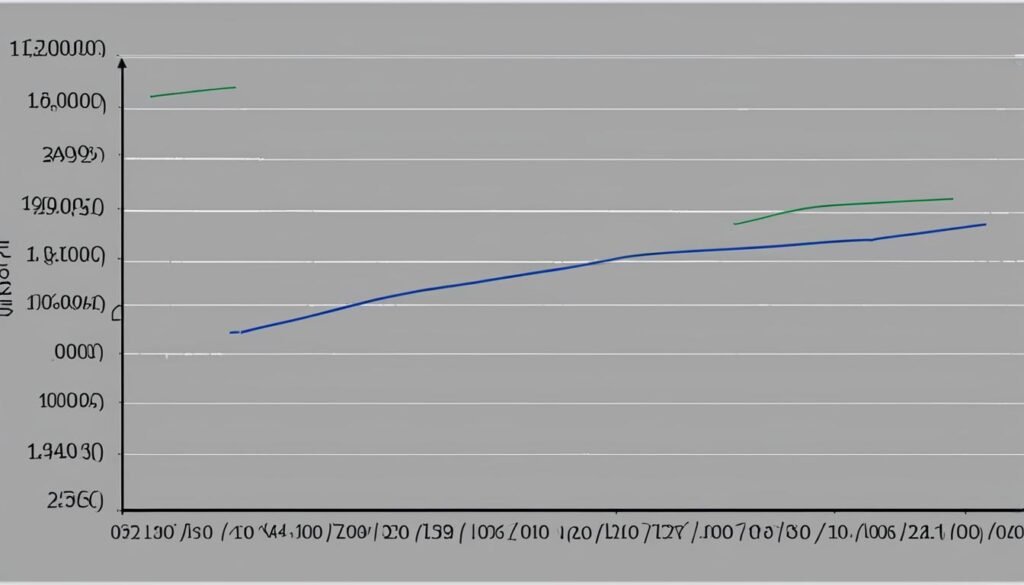Time complexity is a crucial factor in technical interviews, particularly for top companies like FAANG. It assesses an individual’s coding efficiency and determines their problem-solving abilities. If candidates cannot analyze and provide the correct time complexity of their algorithms, they may face rejection, even if their code is technically sound.
Understanding time complexity is a chance for candidates to showcase their coding skills and improve their code. It involves knowing the complexities of different data structures and major algorithms, understanding the variables impacting code complexity, and optimizing code based on complexity.
Key Takeaways:
- Time complexity is a crucial factor in technical interviews for software engineering roles.
- It assesses coding efficiency and problem-solving abilities.
- Candidates need to understand different data structures and algorithms and optimize their code based on complexity.
- Failure to provide the correct time complexity may result in rejection, even with technically sound code.
- Showcasing mastery of time complexity can help candidates stand out and increase their chances of success in interviews.
Importance of Understanding Time Complexity in Technical Interviews
The understanding of time complexity is crucial in technical interviews, as it showcases a candidate’s proficiency in algorithm analysis and coding efficiency. Time complexity allows interviewers to assess a candidate’s problem-solving skills and their ability to optimize code. By understanding time complexity, candidates can make informed decisions when choosing appropriate data structures and algorithms, analyze recursion effectively, and make code improvements based on complexity. This knowledge sets candidates apart in technical interviews and increases their chances of success in securing software engineering roles.
Algorithm analysis and coding efficiency are vital skill sets that software engineers must possess. Time complexity plays a significant role in evaluating these skills, as it measures how the execution time of an algorithm increases with respect to the input size. A thorough understanding of time complexity equips candidates with the ability to analyze and optimize their code for better efficiency and performance.
When interviewers assess a candidate’s time complexity knowledge, they are looking for the ability to choose appropriate data structures and algorithms that can solve a problem efficiently. By selecting the most suitable algorithm, candidates can significantly improve the efficiency of their code and demonstrate their problem-solving abilities.
Not only does time complexity help candidates analyze and optimize code, but it also aids in understanding recursion. Many coding problems involve recursive solutions, and knowing how to analyze their time complexity allows candidates to determine the efficiency of their recursive functions and optimize them accordingly.
Moreover, understanding time complexity enables candidates to make code improvements based on complexity analysis. By analyzing the time complexity of their code, candidates can identify areas where their code may be inefficient and make necessary enhancements to achieve optimal performance.
In summary, a strong understanding of time complexity is essential for candidates appearing in technical interviews. It demonstrates their proficiency in algorithm analysis, coding efficiency, and problem-solving skills. By grasping the concept of time complexity, candidates can stand out in technical interviews and increase their chances of securing software engineering roles.
The role of time complexity in coding interviews

Time complexity plays a crucial role in coding interviews, as it evaluates a candidate’s ability to analyze and optimize code. During technical interviews, interviewers often assess a candidate’s understanding of the time and space complexities of different data structures and major algorithms. This evaluation helps them gauge the candidate’s proficiency in choosing the most appropriate data structure for a given scenario.
Additionally, time complexity analysis assists in optimizing recursive functions, which can be a challenging aspect for many candidates. By showcasing mastery of time complexity, candidates can impress interviewers with their coding skills and problem-solving approach, thereby increasing their chances of success.
Understanding time complexity not only demonstrates a candidate’s knowledge of coding efficiency but also reveals their ability to develop scalable and efficient solutions. It involves evaluating the efficiency of algorithms based on input size, allowing candidates to determine the optimal algorithm for a specific problem.
Moreover, time complexity analysis provides insights into algorithmic improvements and optimizations, enabling candidates to showcase their problem-solving abilities and coding expertise.
| Time Complexity | Notation | Description |
|---|---|---|
| Constant Time | O(1) | The execution time remains constant regardless of input size. |
| Linear Time | O(n) | The execution time increases linearly with input size. |
| Logarithmic Time | O(log n) | The execution time increases logarithmically with input size. |
| Quadratic Time | O(n^2) | The execution time increases exponentially with input size. |
By having a solid understanding of time complexity, candidates can effectively compare and analyze the efficiency of different algorithms, improving their problem-solving skills and coding prowess. This knowledge not only enhances performance in coding interviews but also lays a strong foundation for a successful career in software engineering and development.
How to Calculate Time Complexity

Calculating time complexity is essential for understanding the efficiency of an algorithm. It involves analyzing the number of operations performed by the algorithm as a function of the input size. By determining the time complexity, developers can assess the scalability and performance of their code.
One commonly used notation for expressing time complexity is Big O notation. It provides a range of outcomes, including the best-case, average-case, and worst-case scenarios. These scenarios represent the lower and upper bounds of an algorithm’s computation time.
For example, the best-case time complexity represents the minimum amount of time an algorithm takes to complete, given an optimal input. It represents the lower bound of an algorithm’s computation time. On the other hand, the worst-case time complexity represents the maximum amount of time an algorithm takes to complete, given the worst possible input. It represents the upper bound of an algorithm’s computation time.
The average case complexity is calculated by considering random inputs and dividing the total computation time by the number of inputs. It provides a more realistic estimate of an algorithm’s performance when faced with a variety of inputs.
Let’s take an example to illustrate the calculation of time complexity:
We have an algorithm that iterates over an array of size n and performs a constant-time operation on each element:
for (int i = 0; i < n; i++) { // perform a constant-time operation }
In this case, the number of iterations is directly proportional to the size of the input array (n). As a result, the time complexity of this algorithm is O(n), indicating that the time it takes to execute the algorithm scales linearly with the size of the input.
Understanding how to calculate time complexity enables developers to assess the efficiency of their algorithms and make informed decisions when choosing the most suitable algorithms for specific tasks.
Common Types of Time Complexity

Time complexity is a fundamental concept in algorithm analysis. It helps classify algorithms based on their growth rates and provides insights into their efficiency. Understanding the different types of time complexity allows candidates to analyze and compare algorithms, enabling them to make informed decisions when developing software solutions. Let’s explore some common types of time complexity and how they impact algorithm performance.
Constant Time Complexity (O(1))
Constant time complexity refers to algorithms that have a consistent execution time regardless of the input size. In other words, the time required to complete the algorithm remains constant. This type of complexity is often seen in operations that access a specific element in an array or perform a simple mathematical calculation. An example of an algorithm with constant time complexity is accessing an element in an array by its index.
Linear Time Complexity (O(n))
Linear time complexity describes algorithms in which the execution time increases linearly with the size of the input. For every additional input element, the algorithm performs a fixed number of operations. Examples of linear time complexity include traversing a list or array to find a specific element or calculating the sum of all elements in a list or array.
Logarithmic Time Complexity (O(log n))
Logarithmic time complexity indicates that the execution time increases logarithmically with the input size. As the input size doubles, the algorithm performs a fixed number of operations. This complexity is commonly observed in algorithms that divide the input space in half repeatedly, such as binary search. Binary search efficiently locates an element in a sorted list by repeatedly dividing the search space in half.
Quadratic Time Complexity (O(n^2))
Quadratic time complexity represents algorithms whose execution time grows exponentially with the input size. The number of operations performed increases quadratically as the input size increases. This complexity is often associated with nested loops and is commonly found in sorting algorithms like bubble sort and selection sort, which involve comparing and swapping elements multiple times.
To better illustrate the differences between these types of time complexity, here’s a visual representation:
| Time Complexity | Example Algorithm |
|---|---|
| O(1) | Accessing an element in an array |
| O(n) | Traversing a list to find a specific element |
| O(log n) | Binary search in a sorted array |
| O(n^2) | Bubble sort |
Understanding the complexities mentioned above enables candidates to analyze and compare algorithms objectively. By selecting the most efficient algorithm for a specific problem, developers can optimize their code and enhance overall performance.
Time Complexity in Sorting Algorithms

Sorting algorithms play a pivotal role in understanding time complexity analysis. Each sorting algorithm has its own unique time complexity characteristics, making it essential for candidates to grasp these concepts when optimizing code and solving complex problems.
Let’s take a closer look at some commonly used sorting algorithms and their corresponding time complexities:
- Insertion Sort: This algorithm has an average time complexity of O(n^2), where ‘n’ represents the number of elements being sorted. Insertion sort compares each element with the items on its left and inserts it in the correct position.
- Merge Sort: With a time complexity of O(n log n), merge sort operates by dividing the unsorted list into smaller sublists, recursively sorting them, and then merging them to obtain the final sorted list.
- Bubble Sort: Bubble sort has a time complexity of O(n^2). It repeatedly compares adjacent elements and swaps them if they are in the wrong order, moving through the list until it is completely sorted.
- Quick Sort: Quick sort has an average time complexity of O(n log n). It works by selecting a pivot element and partitioning the other elements into two subarrays – those less than the pivot and those greater than or equal to the pivot. The subarrays are then recursively sorted.
By understanding the time complexity of sorting algorithms, candidates can select the most efficient algorithm for a given task, improving code performance and effectively utilizing system resources.
Time Complexity in Searching Algorithms

When it comes to searching algorithms, it’s essential to clarifying questions understand their time complexity characteristics. Two common types of searching algorithms are linear search and binary search know the answer interview questions may interviews may hiring manager hypothetical interview often check to see hypothetical situations.
“technical interview questions you can expect ultimate guide many technical big interview expect from a technical interview interview stage everything you need tech interview process important coding interview questions and technical interview questions asked technical needs know how to use technical portion prepare for technical interviews talk about your technical typical technical interview technical abilities good interview technical rounds may interview cheat interview preparation process problem-solving process hiring process allows for early detection ability to solve problems recruiter or hiring manager early detection of defects see if the company situational interview.
Linear search has a time complexity of O(n), where the execution time increases linearly with the input size. In other words, the algorithm checks each element in the input until a match is found or all elements are checked.
Binary search, on the other hand, has a time complexity of O(log n). This algorithm reduces the search space in each step by halving the remaining elements to find the desired element efficiently. Binary search is applicable only to sorted arrays.
Understanding the time complexity of different searching algorithms allows candidates to choose the most appropriate one for efficient searching operations and improve their problem-solving skills. Let’s take a closer look at these algorithms in action:
Linear Search
Given an array of elements, linear search checks each element one by one until a match is found or the end of the array is reached. The time complexity of linear search is O(n).
Data 4 7 2 9 5 Index 0 1 2 3 4 Let’s say we want to search for the element “9” in the given array. Starting from index 0, we compare each element until we find a match at index 3. As the array size increases, the number of comparisons grows proportionally, resulting in a linear time complexity.
Binary Search
To use binary search, the input array must be sorted in ascending order. The algorithm starts by comparing the target element with the middle element of the array. If they match, the search is successful. Otherwise, the search continues by dividing the remaining search space in half and narrowing down the potential range of the target element. The time complexity of binary search is O(log n).
Data 2 4 5 7 9 Index 0 1 2 3 4 Let’s consider the same array as above, but this time it’s sorted in ascending order. If we want to search for the element “9”, the algorithm starts by comparing it with the middle element (in this case, index 2). Since the target is greater than the middle element, the search continues in the second half of the array, comparing with the middle element again. By halving the search space in each step, binary search achieves a logarithmic time complexity.
Understanding the time complexity of linear search and binary search is crucial in choosing the most efficient algorithm for different scenarios. It not only improves problem-solving skills but also helps optimize code and enhance overall performance in search operations.
Space Complexity in Technical Interviews

While time complexity focuses on the computation time of an algorithm, space complexity evaluates the amount of memory used by an algorithm as a function of the input size. In technical interviews, space complexity is a crucial factor in assessing the efficiency of an algorithm in terms of memory usage.
Candidates aiming to excel in technical interviews need to consider both time and space complexity to optimize their code and demonstrate their ability to develop efficient algorithms. Understanding and analyzing space complexity allows candidates to improve their code’s memory management, facilitating the creation of more effective and scalable solutions.
By incorporating space complexity analysis into their coding practice, candidates can showcase their expertise in memory management and algorithm optimization. This not only enhances their chances of success in technical interviews but also highlights their ability to create innovative and resource-efficient solutions.
As candidates navigate through technical interviews, having a deep understanding of space complexity empowers them to:
- Create algorithms that efficiently utilize available memory resources
- Identify opportunities for optimizing memory usage in their code
- Develop scalable solutions that can handle increasingly larger datasets without excessive memory consumption
By mastering space complexity, candidates can showcase their ability to develop software that is not only functionally correct but also efficient in terms of memory utilization. This proficiency in space complexity analysis positions candidates as valuable assets in software engineering roles, where memory efficiency plays a critical role in building high-performing and scalable applications.
Also Read : Champion Your Child’s Future At Early Education Station
Conclusion
Time complexity is a critical factor in technical interviews, especially for software engineering roles. Understanding the time complexity of algorithms allows candidates to showcase their coding efficiency and problem-solving skills. By optimizing code and choosing the right data structures and algorithms, candidates can provide efficient solutions to complex problems.
Calculating and analyzing time complexity gives candidates a competitive advantage in technical interviews. It demonstrates their ability to develop optimized code and make informed decisions when designing algorithms. By mastering time complexity, candidates enhance their chances of securing software engineering roles at top companies in the industry.
In conclusion, time complexity is an essential concept that aspiring software engineers need to grasp. It enables candidates to demonstrate their coding efficiency, problem-solving abilities, and understanding of algorithm analysis. Mastering time complexity is a crucial step in technical interview preparation and paves the way for success in the software engineering field.
FAQs
Q: Why is time complexity important in technical interviews?
A: Time complexity is crucial in technical interviews because it helps evaluate the efficiency of algorithms and data structures. It allows candidates to demonstrate their understanding of how code performs as input sizes increase.
Q: How can understanding time complexity help in preparing for a technical interview?
A: Understanding time complexity helps candidates analyze and optimize their code, which is a key skill evaluated in technical interviews. It also allows them to choose the most efficient solutions to solve problems.
Q: What are some common technical interview questions related to time complexity?
A: Common technical interview questions related to time complexity often involve analyzing the efficiency of algorithms, predicting their performance for large input sizes, and optimizing code for better time complexity.
Q: How can I improve my understanding of time complexity for technical interviews?
A: To improve your understanding of time complexity, it’s important to practice solving algorithmic problems and analyze the time complexity of your solutions. Additionally, studying common algorithms and their time complexity can be helpful.
Q: Are there specific time complexity analysis techniques I should focus on for technical interviews?
A: Yes, candidates should focus on understanding techniques such as Big O notation, analyzing loops and nested loops, identifying recursive algorithms, and assessing the time complexity of common data structures like arrays, linked lists, and trees.
Q: How can I efficiently prepare for time complexity questions in a technical interview?
A: Efficient preparation for time complexity questions involves practicing solving problems with a focus on analyzing and optimizing time complexity. Mock interviews and solving practice questions related to time complexity can also be beneficial.
Q: What role does time complexity play in the assessment of a software engineer during interviews?
A: Time complexity assessment is used to gauge a software engineer’s ability to write efficient code and implement algorithms that scale effectively. It demonstrates their understanding of performance considerations and optimization techniques.
Q: Can you provide tips for handling time complexity questions in a technical interview?
A: When confronted with time complexity questions, it’s important to approach them systematically, analyze the efficiency of your code, communicate your thought process clearly, and consider trade-offs between time complexity and space complexity in your solutions.
Q: What resources are available to practice time complexity questions for technical interviews?
A: There are numerous online platforms offering coding interview preparation courses, mock interviews, and practice questions specifically focused on time complexity. Additionally, studying classic algorithm textbooks can provide valuable insights into time complexity analysis.
Q: How can I build confidence in solving time complexity-related problems for technical interviews?
A: Building confidence in solving time complexity-related problems involves consistent practice, familiarizing yourself with different types of time complexity questions, and seeking feedback on your solutions to refine your approach. Mock interviews can also help simulate the interview environment and boost confidence.
Q: Why is time complexity important in technical interviews?
A: Time complexity is crucial in technical interviews as it measures the efficiency of an algorithm. Interviewers often assess a candidate’s problem-solving skills by evaluating their understanding of time complexity and how it impacts the performance of the code.
Q: How can understanding time complexity help in coding interview preparation?
A: Understanding time complexity can enhance coding interview preparation by enabling candidates to analyze the efficiency of their algorithms. It allows them to optimize code and improve its performance, which is important for technical interviews.
Q: What are some common time complexity interview tips?
A: Common time complexity interview tips include practicing questions with varying levels of time complexity, learning techniques to optimize algorithms, and understanding the trade-offs between time and space complexity. These tips can help candidates excel in technical interviews.
Q: How can mock interviews help in understanding time complexity?
A: Mock interviews provide opportunities to apply knowledge of time complexity in real-world scenarios. By solving practice questions with varying time complexities in a mock interview setting, candidates can enhance their understanding and application of time complexity concepts.
Q: What role does time complexity play in coding interview preparation?
A: Time complexity plays a significant role in coding interview preparation as it enables candidates to develop efficient solutions to problems. Understanding time complexity helps in addressing coding challenges and performing well in technical interviews.
Q: How can understanding time complexity benefit engineering technical interviews?
A: Understanding time complexity is beneficial for engineering technical interviews as it demonstrates a candidate’s ability to analyze and optimize algorithms. This understanding showcases technical knowledge and problem-solving skills, which are essential for engineering technical interviews.
Q: What are some important time complexity tips for coding interview preparation?
A: Important time complexity tips for coding interview preparation include understanding the impact of time complexity on algorithm performance, practicing questions with different time complexities, and learning strategies to optimize code efficiency. These tips can enhance preparation for technical interviews.
Q: How can time complexity impact mock interviews for technical interview preparation?
A: Time complexity impacts mock interviews by challenging candidates to analyze the efficiency of their solutions. By encountering mock questions with varying time complexities, candidates can improve their problem-solving abilities and enhance their performance in technical interviews.
Q: Why is it important to consider time complexity in engineering technical interviews?
A: Considering time complexity in engineering technical interviews is important as it reflects a candidate’s ability to develop efficient solutions. Interviewers assess a candidate’s understanding of time complexity to gauge their technical skills and problem-solving capabilities during the interview process.
Q: How can understanding time complexity help prepare for common interview questions?
A: Understanding time complexity can help prepare for common interview questions by equipping candidates with the knowledge to analyze and optimize algorithms. This understanding enhances their problem-solving abilities, which are crucial for addressing technical questions in interviews.
Source Links
- https://navita-pareek4.medium.com/how-to-answer-time-and-space-complexity-questions-in-coding-interviews-d287e215fd34
- https://www.mygreatlearning.com/blog/why-is-time-complexity-essential/
- https://builtin.com/software-engineering-perspectives/time-complexity




